service DODGE DART 2014 PF / 1.G Owners Manual
[x] Cancel search | Manufacturer: DODGE, Model Year: 2014, Model line: DART, Model: DODGE DART 2014 PF / 1.GPages: 656, PDF Size: 4.73 MB
Page 6 of 656
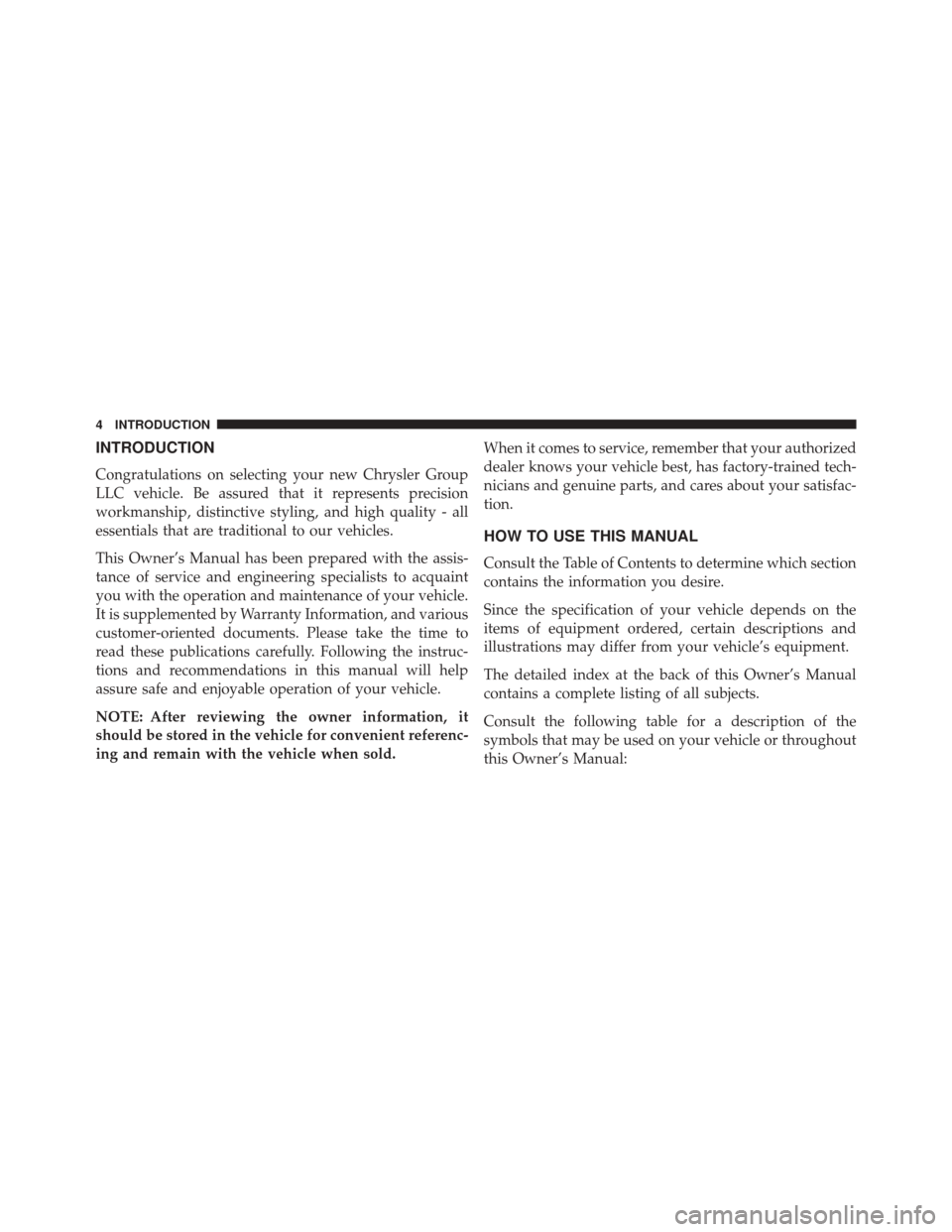
INTRODUCTION
Congratulations on selecting your new Chrysler Group
LLC vehicle. Be assured that it represents precision
workmanship, distinctive styling, and high quality - all
essentials that are traditional to our vehicles.
This Owner’s Manual has been prepared with the assis-
tance of service and engineering specialists to acquaint
you with the operation and maintenance of your vehicle.
It is supplemented by Warranty Information, and various
customer-oriented documents. Please take the time to
read these publications carefully. Following the instruc-
tions and recommendations in this manual will help
assure safe and enjoyable operation of your vehicle.
NOTE: After reviewing the owner information, it
should be stored in the vehicle for convenient referenc-
ing and remain with the vehicle when sold.When it comes to service, remember that your authorized
dealer knows your vehicle best, has factory-trained tech-
nicians and genuine parts, and cares about your satisfac-
tion.
HOW TO USE THIS MANUAL
Consult the Table of Contents to determine which section
contains the information you desire.
Since the specification of your vehicle depends on the
items of equipment ordered, certain descriptions and
illustrations may differ from your vehicle’s equipment.
The detailed index at the back of this Owner’s Manual
contains a complete listing of all subjects.
Consult the following table for a description of the
symbols that may be used on your vehicle or throughout
this Owner’s Manual:
4 INTRODUCTION
Page 20 of 656

The system uses a Key or Key Fob with Remote Keyless
Entry (RKE) transmitter, an RF receiver, and either an
Ignition Node Module (IGNM) or a Keyless Ignition
Node (KIN) to prevent unauthorized vehicle operation.
Therefore, only Keys or Key Fobs that are programmed to
the vehicle can be used to start and operate the vehicle.
After placing the ignition in the ON/RUN position, the
Vehicle Security Light will turn on for three seconds for a
bulb check. If the light remains on after the bulb check, it
indicates that there is a problem with the electronics. In
addition, if the light begins to flash after the bulb check,
it indicates that someone used an invalid Key Fob to start
the engine. Either of these conditions will result in the
engine being shut off after two seconds.If the Vehicle Security Light turns on during normal
vehicle operation (vehicle running for longer than 10
seconds), it indicates that there is a fault in the electron-
ics. Should this occur, have the vehicle serviced as soon
as possible by an authorized dealer.
CAUTION!
The Sentry Key® Immobilizer system is not compat-
ible with some aftermarket remote starting systems.
Use of these systems may result in vehicle starting
problems and loss of security protection.
All of the Key Fobs provided with your new vehicle have
been programmed to the vehicle electronics.
18 THINGS TO KNOW BEFORE STARTING YOUR VEHICLE
Page 21 of 656
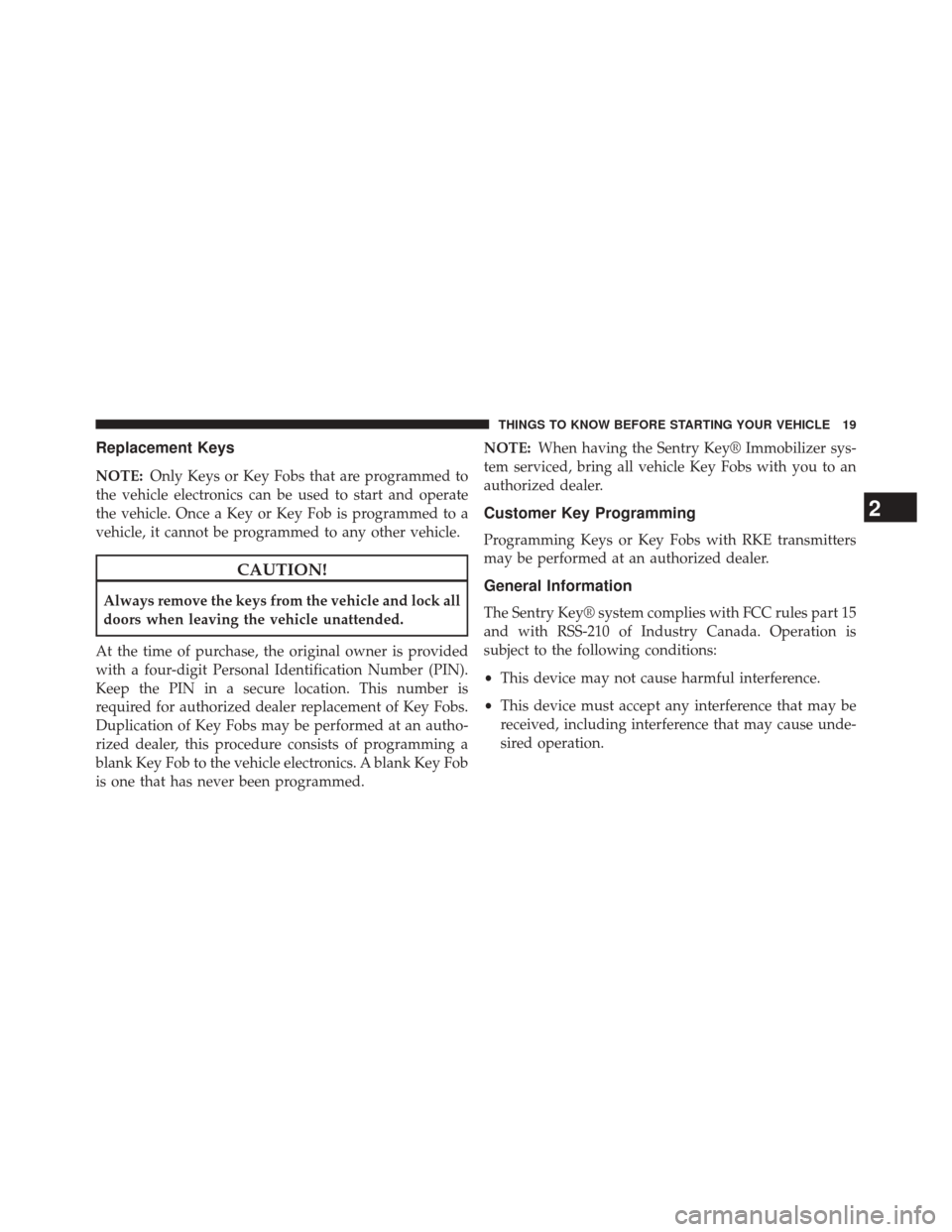
Replacement Keys
NOTE:Only Keys or Key Fobs that are programmed to
the vehicle electronics can be used to start and operate
the vehicle. Once a Key or Key Fob is programmed to a
vehicle, it cannot be programmed to any other vehicle.
CAUTION!
Always remove the keys from the vehicle and lock all
doors when leaving the vehicle unattended.
At the time of purchase, the original owner is provided
with a four-digit Personal Identification Number (PIN).
Keep the PIN in a secure location. This number is
required for authorized dealer replacement of Key Fobs.
Duplication of Key Fobs may be performed at an autho-
rized dealer, this procedure consists of programming a
blank Key Fob to the vehicle electronics. A blank Key Fob
is one that has never been programmed. NOTE:
When having the Sentry Key® Immobilizer sys-
tem serviced, bring all vehicle Key Fobs with you to an
authorized dealer.
Customer Key Programming
Programming Keys or Key Fobs with RKE transmitters
may be performed at an authorized dealer.
General Information
The Sentry Key® system complies with FCC rules part 15
and with RSS-210 of Industry Canada. Operation is
subject to the following conditions:
• This device may not cause harmful interference.
• This device must accept any interference that may be
received, including interference that may cause unde-
sired operation.
2
THINGS TO KNOW BEFORE STARTING YOUR VEHICLE 19
Page 36 of 656
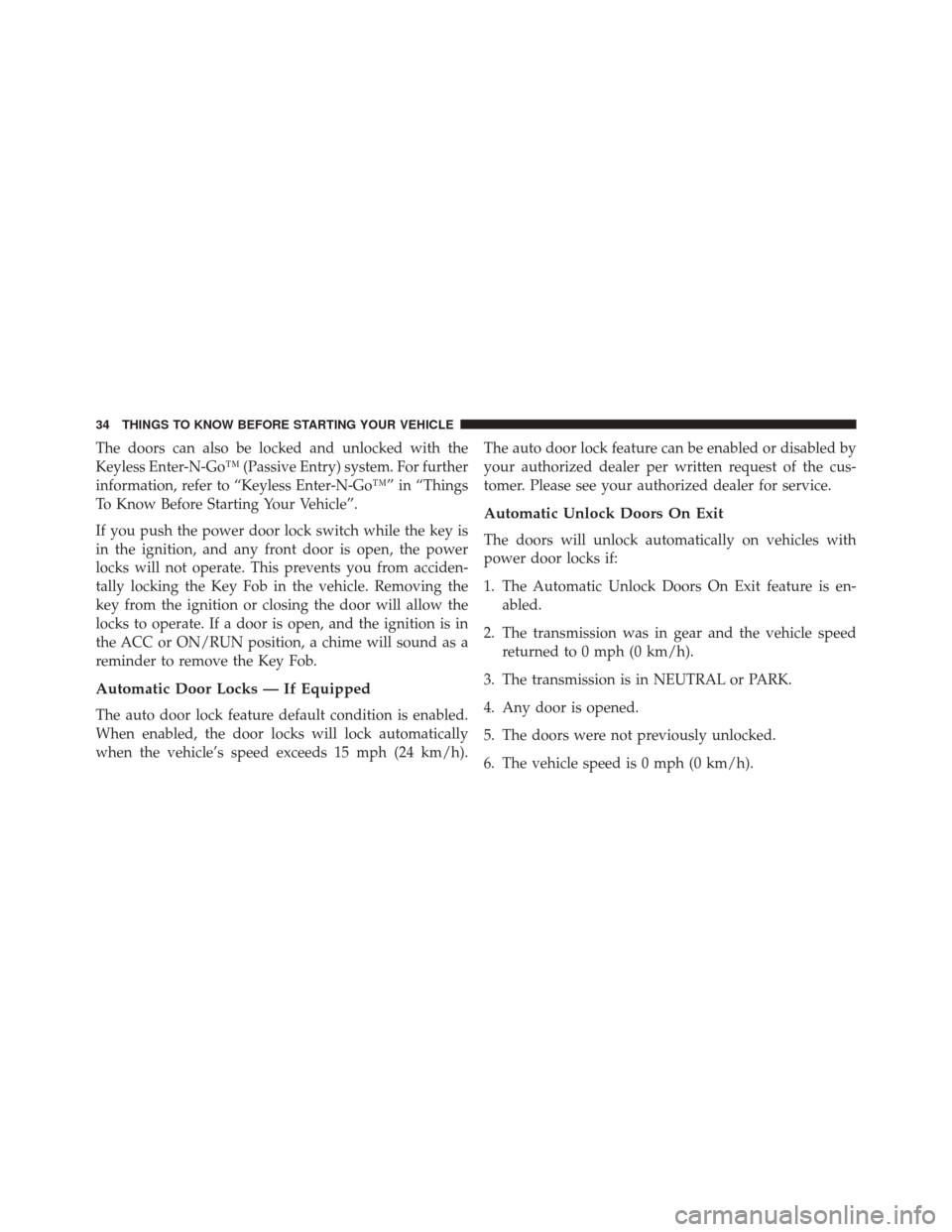
The doors can also be locked and unlocked with the
Keyless Enter-N-Go™ (Passive Entry) system. For further
information, refer to “Keyless Enter-N-Go™” in “Things
To Know Before Starting Your Vehicle”.
If you push the power door lock switch while the key is
in the ignition, and any front door is open, the power
locks will not operate. This prevents you from acciden-
tally locking the Key Fob in the vehicle. Removing the
key from the ignition or closing the door will allow the
locks to operate. If a door is open, and the ignition is in
the ACC or ON/RUN position, a chime will sound as a
reminder to remove the Key Fob.
Automatic Door Locks — If Equipped
The auto door lock feature default condition is enabled.
When enabled, the door locks will lock automatically
when the vehicle’s speed exceeds 15 mph (24 km/h).The auto door lock feature can be enabled or disabled by
your authorized dealer per written request of the cus-
tomer. Please see your authorized dealer for service.
Automatic Unlock Doors On Exit
The doors will unlock automatically on vehicles with
power door locks if:
1. The Automatic Unlock Doors On Exit feature is en-
abled.
2. The transmission was in gear and the vehicle speed returned to 0 mph (0 km/h).
3. The transmission is in NEUTRAL or PARK.
4. Any door is opened.
5. The doors were not previously unlocked.
6. The vehicle speed is 0 mph (0 km/h).
34 THINGS TO KNOW BEFORE STARTING YOUR VEHICLE
Page 60 of 656
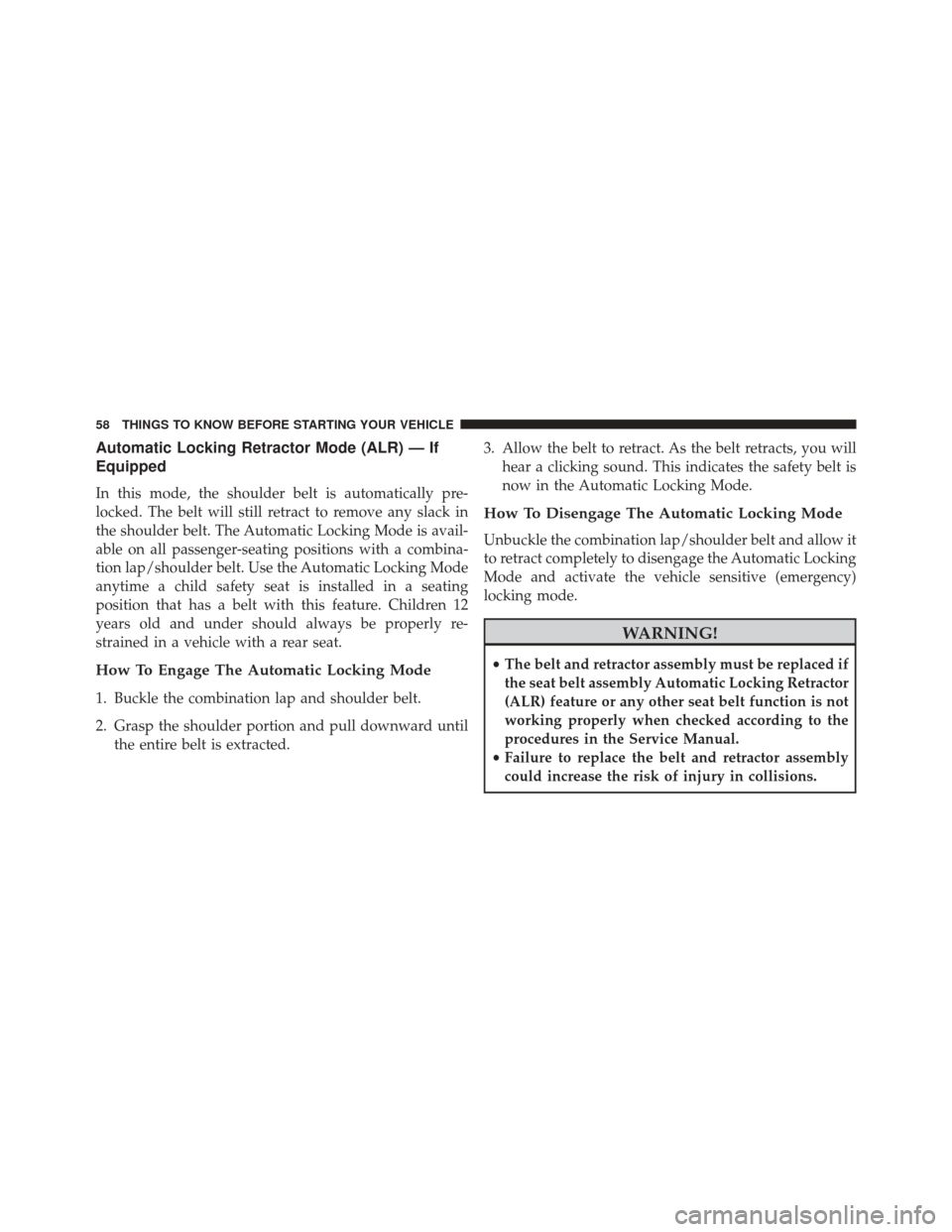
Automatic Locking Retractor Mode (ALR) — If
Equipped
In this mode, the shoulder belt is automatically pre-
locked. The belt will still retract to remove any slack in
the shoulder belt. The Automatic Locking Mode is avail-
able on all passenger-seating positions with a combina-
tion lap/shoulder belt. Use the Automatic Locking Mode
anytime a child safety seat is installed in a seating
position that has a belt with this feature. Children 12
years old and under should always be properly re-
strained in a vehicle with a rear seat.
How To Engage The Automatic Locking Mode
1. Buckle the combination lap and shoulder belt.
2. Grasp the shoulder portion and pull downward untilthe entire belt is extracted. 3. Allow the belt to retract. As the belt retracts, you will
hear a clicking sound. This indicates the safety belt is
now in the Automatic Locking Mode.
How To Disengage The Automatic Locking Mode
Unbuckle the combination lap/shoulder belt and allow it
to retract completely to disengage the Automatic Locking
Mode and activate the vehicle sensitive (emergency)
locking mode.
WARNING!
•The belt and retractor assembly must be replaced if
the seat belt assembly Automatic Locking Retractor
(ALR) feature or any other seat belt function is not
working properly when checked according to the
procedures in the Service Manual.
• Failure to replace the belt and retractor assembly
could increase the risk of injury in collisions.
58 THINGS TO KNOW BEFORE STARTING YOUR VEHICLE
Page 71 of 656
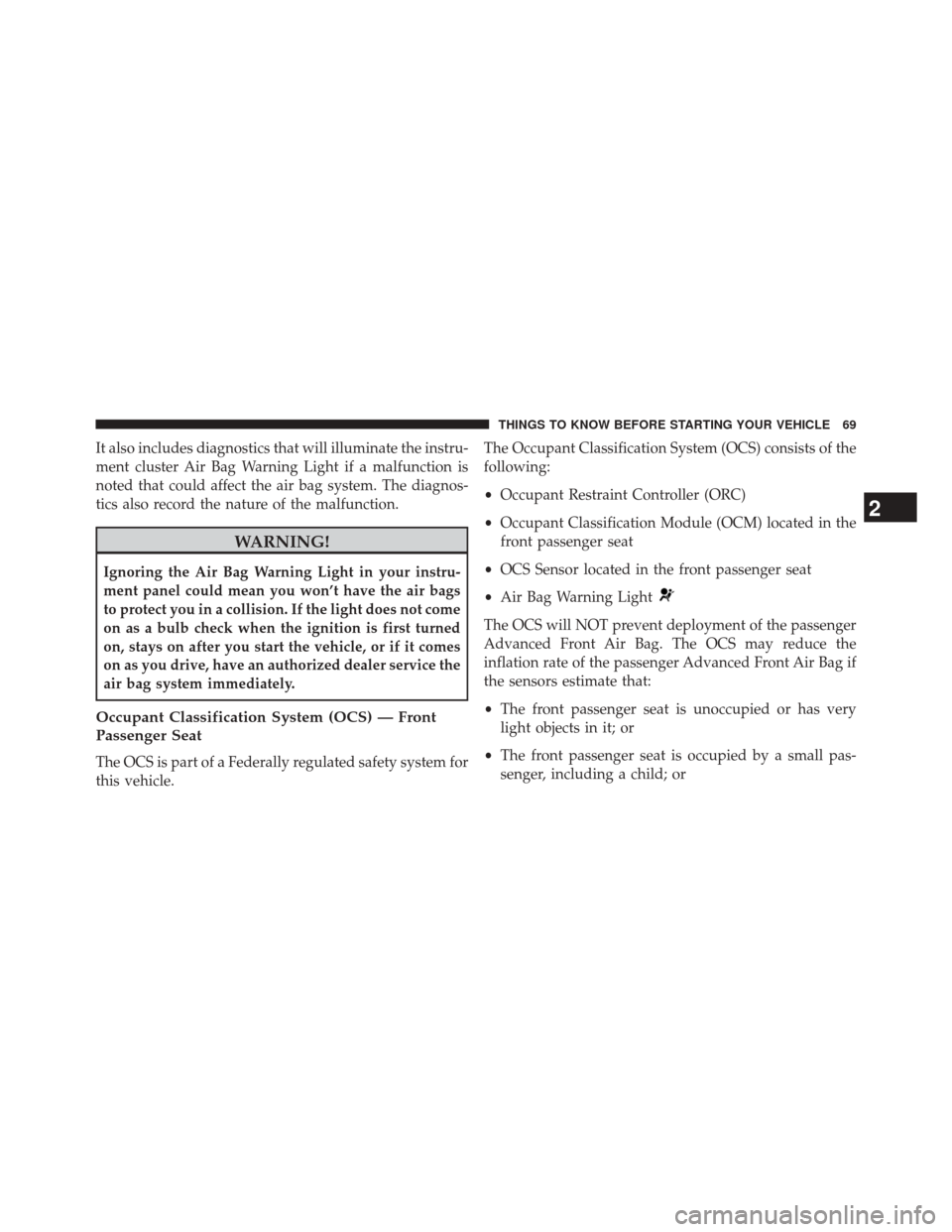
It also includes diagnostics that will illuminate the instru-
ment cluster Air Bag Warning Light if a malfunction is
noted that could affect the air bag system. The diagnos-
tics also record the nature of the malfunction.
WARNING!
Ignoring the Air Bag Warning Light in your instru-
ment panel could mean you won’t have the air bags
to protect you in a collision. If the light does not come
on as a bulb check when the ignition is first turned
on, stays on after you start the vehicle, or if it comes
on as you drive, have an authorized dealer service the
air bag system immediately.
Occupant Classification System (OCS) — Front
Passenger Seat
The OCS is part of a Federally regulated safety system for
this vehicle.The Occupant Classification System (OCS) consists of the
following:
•
Occupant Restraint Controller (ORC)
• Occupant Classification Module (OCM) located in the
front passenger seat
• OCS Sensor located in the front passenger seat
• Air Bag Warning Light
The OCS will NOT prevent deployment of the passenger
Advanced Front Air Bag. The OCS may reduce the
inflation rate of the passenger Advanced Front Air Bag if
the sensors estimate that:
•The front passenger seat is unoccupied or has very
light objects in it; or
• The front passenger seat is occupied by a small pas-
senger, including a child; or
2
THINGS TO KNOW BEFORE STARTING YOUR VEHICLE 69
Page 77 of 656
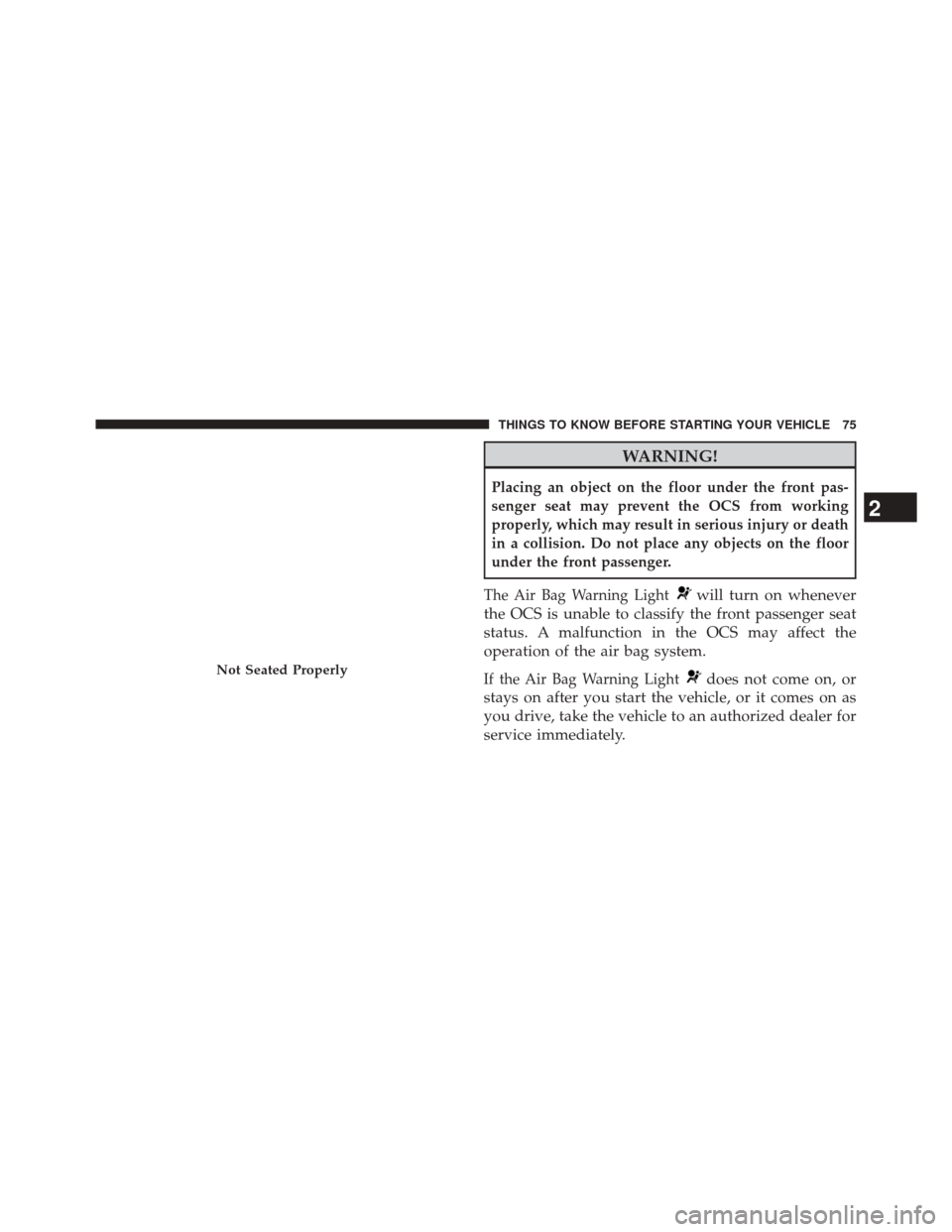
WARNING!
Placing an object on the floor under the front pas-
senger seat may prevent the OCS from working
properly, which may result in serious injury or death
in a collision. Do not place any objects on the floor
under the front passenger.
The Air Bag Warning Light
will turn on whenever
the OCS is unable to classify the front passenger seat
status. A malfunction in the OCS may affect the
operation of the air bag system.
If the Air Bag Warning Lightdoes not come on, or
stays on after you start the vehicle, or it comes on as
you drive, take the vehicle to an authorized dealer for
service immediately.Not Seated Properly
2
THINGS TO KNOW BEFORE STARTING YOUR VEHICLE 75
Page 78 of 656
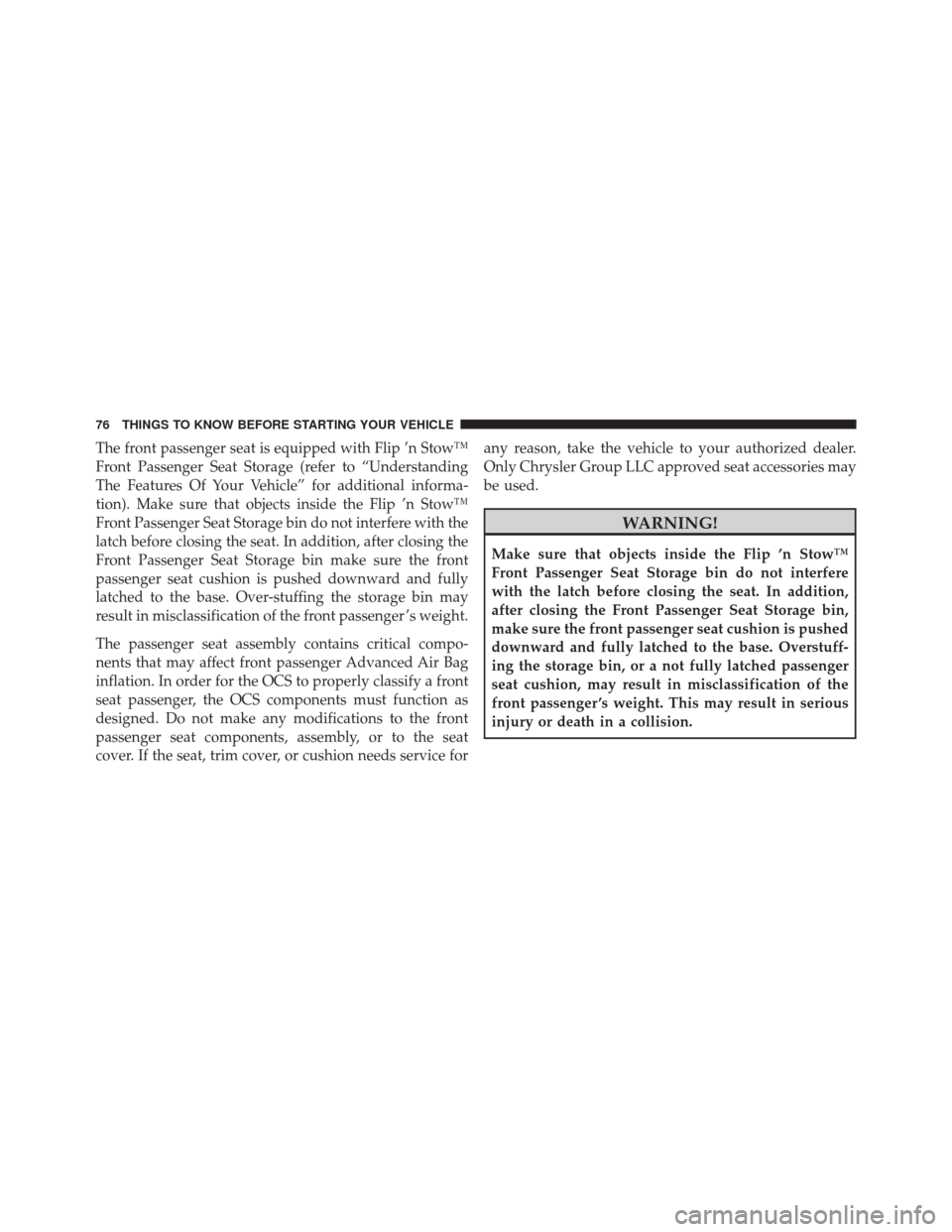
The front passenger seat is equipped with Flip ’n Stow™
Front Passenger Seat Storage (refer to “Understanding
The Features Of Your Vehicle” for additional informa-
tion). Make sure that objects inside the Flip ’n Stow™
Front Passenger Seat Storage bin do not interfere with the
latch before closing the seat. In addition, after closing the
Front Passenger Seat Storage bin make sure the front
passenger seat cushion is pushed downward and fully
latched to the base. Over-stuffing the storage bin may
result in misclassification of the front passenger ’s weight.
The passenger seat assembly contains critical compo-
nents that may affect front passenger Advanced Air Bag
inflation. In order for the OCS to properly classify a front
seat passenger, the OCS components must function as
designed. Do not make any modifications to the front
passenger seat components, assembly, or to the seat
cover. If the seat, trim cover, or cushion needs service forany reason, take the vehicle to your authorized dealer.
Only Chrysler Group LLC approved seat accessories may
be used.
WARNING!
Make sure that objects inside the Flip ’n Stow™
Front Passenger Seat Storage bin do not interfere
with the latch before closing the seat. In addition,
after closing the Front Passenger Seat Storage bin,
make sure the front passenger seat cushion is pushed
downward and fully latched to the base. Overstuff-
ing the storage bin, or a not fully latched passenger
seat cushion, may result in misclassification of the
front passenger ’s weight. This may result in serious
injury or death in a collision.
76 THINGS TO KNOW BEFORE STARTING YOUR VEHICLE
Page 79 of 656
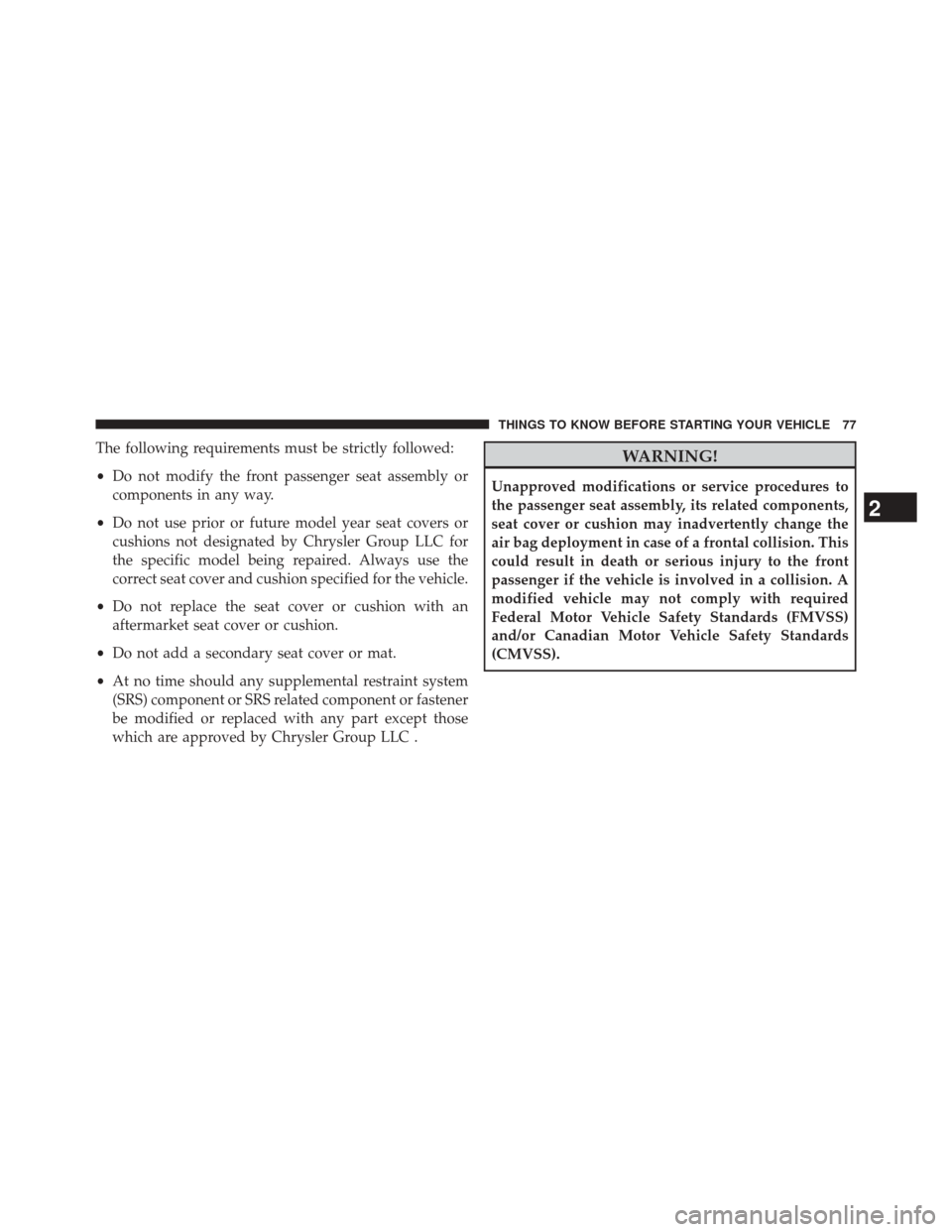
The following requirements must be strictly followed:
•Do not modify the front passenger seat assembly or
components in any way.
• Do not use prior or future model year seat covers or
cushions not designated by Chrysler Group LLC for
the specific model being repaired. Always use the
correct seat cover and cushion specified for the vehicle.
• Do not replace the seat cover or cushion with an
aftermarket seat cover or cushion.
• Do not add a secondary seat cover or mat.
• At no time should any supplemental restraint system
(SRS) component or SRS related component or fastener
be modified or replaced with any part except those
which are approved by Chrysler Group LLC .WARNING!
Unapproved modifications or service procedures to
the passenger seat assembly, its related components,
seat cover or cushion may inadvertently change the
air bag deployment in case of a frontal collision. This
could result in death or serious injury to the front
passenger if the vehicle is involved in a collision. A
modified vehicle may not comply with required
Federal Motor Vehicle Safety Standards (FMVSS)
and/or Canadian Motor Vehicle Safety Standards
(CMVSS).
2
THINGS TO KNOW BEFORE STARTING YOUR VEHICLE 77
Page 83 of 656
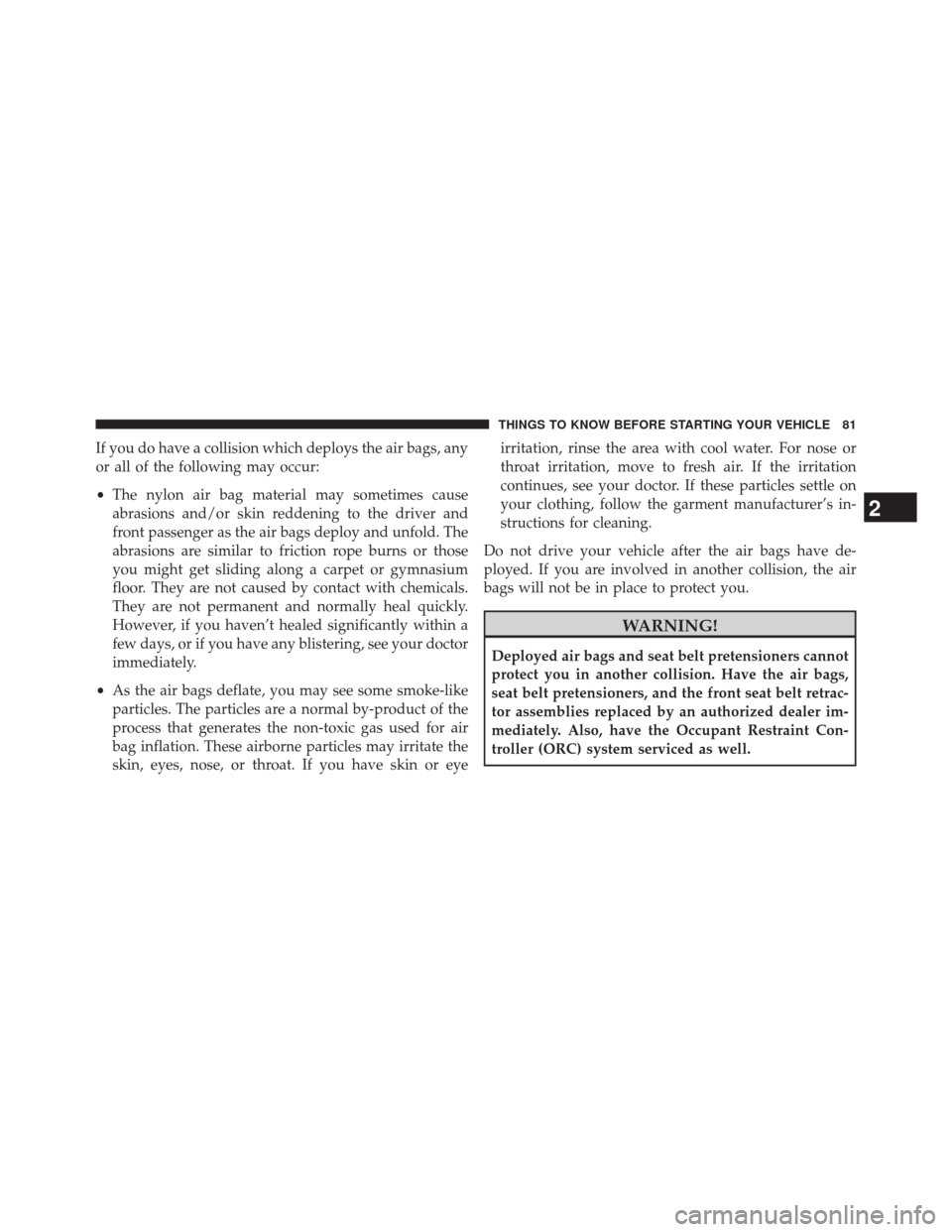
If you do have a collision which deploys the air bags, any
or all of the following may occur:
•The nylon air bag material may sometimes cause
abrasions and/or skin reddening to the driver and
front passenger as the air bags deploy and unfold. The
abrasions are similar to friction rope burns or those
you might get sliding along a carpet or gymnasium
floor. They are not caused by contact with chemicals.
They are not permanent and normally heal quickly.
However, if you haven’t healed significantly within a
few days, or if you have any blistering, see your doctor
immediately.
• As the air bags deflate, you may see some smoke-like
particles. The particles are a normal by-product of the
process that generates the non-toxic gas used for air
bag inflation. These airborne particles may irritate the
skin, eyes, nose, or throat. If you have skin or eye irritation, rinse the area with cool water. For nose or
throat irritation, move to fresh air. If the irritation
continues, see your doctor. If these particles settle on
your clothing, follow the garment manufacturer’s in-
structions for cleaning.
Do not drive your vehicle after the air bags have de-
ployed. If you are involved in another collision, the air
bags will not be in place to protect you.
WARNING!
Deployed air bags and seat belt pretensioners cannot
protect you in another collision. Have the air bags,
seat belt pretensioners, and the front seat belt retrac-
tor assemblies replaced by an authorized dealer im-
mediately. Also, have the Occupant Restraint Con-
troller (ORC) system serviced as well.
2
THINGS TO KNOW BEFORE STARTING YOUR VEHICLE 81